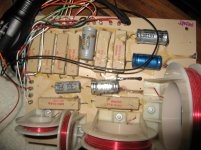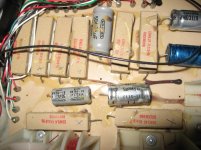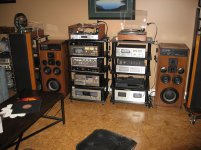The story is:
I purchased a pair of speakers from an older, middle aged (like myself) couple who were moving town to town. They had a deadline and did not wish to transport large speakers. They advertised locally for little money which was how I came to have them.
After becoming the owner of these speakers, I was encouraged to replace the electrolytic capacitors with metal film and also change the resistors. I am on the brink of ordering the film capacitors with the specified brand/series from a recommended vendor for which I was provided a link. I realize the need to be creative dealing with physical size differences going from electrolytic to film but I have some ideas.
But I am not convinced the resistors need replacing being as they are the white rectangular ceramic/Cermet/cement type. In trying to measure them, I believe my DMM is incapable of coping with resistors that large. But be that as it may, I had the notion that this type of resistor was impervious to degradation unless subject to abuse as in visibly scoarched from getting too hot.
I do not dabble in electronics extensively but do so from time to time. Consequently I only replaced this type of resistor twice. Both occasions because it had obviously gotten hot. Once was in an integrated amplifier and the other, coincidentally, was in speaker crossovers. In the case of the speakers, I knew the previous owner, a headbanger who continually played his system beyond sane volumes for decades.
The vendor I was given the link to also has resistors but not in the values I would need. Nor do some other vendors I have bought from before. So, I am inclined to leave the originals in place as there is no evidence what so ever that they have gotten hot at any time. I am also taking into consideration that the previous owners, also original purchasers, had taste in music along the lines of classical, jazz and folk.
Despite that they are 40 plus years old, would not this type of resitors still be OK?
I purchased a pair of speakers from an older, middle aged (like myself) couple who were moving town to town. They had a deadline and did not wish to transport large speakers. They advertised locally for little money which was how I came to have them.
After becoming the owner of these speakers, I was encouraged to replace the electrolytic capacitors with metal film and also change the resistors. I am on the brink of ordering the film capacitors with the specified brand/series from a recommended vendor for which I was provided a link. I realize the need to be creative dealing with physical size differences going from electrolytic to film but I have some ideas.
But I am not convinced the resistors need replacing being as they are the white rectangular ceramic/Cermet/cement type. In trying to measure them, I believe my DMM is incapable of coping with resistors that large. But be that as it may, I had the notion that this type of resistor was impervious to degradation unless subject to abuse as in visibly scoarched from getting too hot.
I do not dabble in electronics extensively but do so from time to time. Consequently I only replaced this type of resistor twice. Both occasions because it had obviously gotten hot. Once was in an integrated amplifier and the other, coincidentally, was in speaker crossovers. In the case of the speakers, I knew the previous owner, a headbanger who continually played his system beyond sane volumes for decades.
The vendor I was given the link to also has resistors but not in the values I would need. Nor do some other vendors I have bought from before. So, I am inclined to leave the originals in place as there is no evidence what so ever that they have gotten hot at any time. I am also taking into consideration that the previous owners, also original purchasers, had taste in music along the lines of classical, jazz and folk.
Despite that they are 40 plus years old, would not this type of resitors still be OK?
Attachments
Last edited:
I can't see anything wrong with those ceramic, wire wound resistors.
Unless grossly abused at some point in future, they will outlive you!
Changing out the electrolytics is sufficient. A good case can be made for replacing them with new, higher quality non polar (NP) electrolytics rather than film caps as this is more likely to emulate the original sound balance.
Unless grossly abused at some point in future, they will outlive you!
Changing out the electrolytics is sufficient. A good case can be made for replacing them with new, higher quality non polar (NP) electrolytics rather than film caps as this is more likely to emulate the original sound balance.
Last edited:
What gives you the impression your DMM cannot measure these resistors? That seems very... Odd. Maybe you just don't have a good connection.
Your dmm will have no problem measuring those resistors.Physical size has nothing to do with the measurement.The only trouble with resistor measurements with a dmm is if the resistance is small,less than 1/2 ohm or so.
Last edited:
Accurate measurements of these resistors cannot be made unless you lift them from the board. I suggest you do not do that - leave well enough alone!
Everything looks ok. I'd only replace the capacitors (if anything),
especially since the resistors are custom made, unavailable values.
especially since the resistors are custom made, unavailable values.
Last edited:
Yes, I noticed those custom values e.g. 8.27 ohm and 3.46 ohm!
It would be interesting to learn which loudspeakers these crossovers are from.
It would be interesting to learn which loudspeakers these crossovers are from.
Changing electrolytic capacitors to film types will change the crossover. Electrolytic's have higher internal equivalent resistance.
You may have problems measuring those resistors due to the sealant goop they dropped all over it, it prevents a good contact with your test probe.
To measure you should scrape clean the endearment point on the wire.
Jan
To measure you should scrape clean the endearment point on the wire.
Jan
Thanks for the speaker identification.
I'm always interested in vintage speakers like these.
https://www.canadianhifi.com/sites/...nuals/KOSS CM Series Loudspeaker Brochure.pdf
I'm always interested in vintage speakers like these.
https://www.canadianhifi.com/sites/...nuals/KOSS CM Series Loudspeaker Brochure.pdf
Yes, I noticed those custom values e.g. 8.27 ohm and 3.46 ohm!
It would be interesting to learn which loudspeakers these crossovers are from.
Well, Koss could have afforded that.
Thanks all, for the input. It did not cross my mind that these resistors might be custom made.
I considered doing bi-polar electrolytics purely from cost and size but no direct replacements for all values were immediatly apparent.
There is a fellow in Ottawa who has extensive experience with the speakers in question and I was going to follow his lead with capacitor replacement. The film types he suggested will require piggybacking 3 of the 5 capacitors present. I anticipate some headscratching in order to anchor them but the speaker cabinet's interior is spacious.
I considered doing bi-polar electrolytics purely from cost and size but no direct replacements for all values were immediatly apparent.
There is a fellow in Ottawa who has extensive experience with the speakers in question and I was going to follow his lead with capacitor replacement. The film types he suggested will require piggybacking 3 of the 5 capacitors present. I anticipate some headscratching in order to anchor them but the speaker cabinet's interior is spacious.
You may have problems measuring those resistors due to the sealant goop they dropped all over it, it prevents a good contact with your test probe.
To measure you should scrape clean the endearment point on the wire.
Jan
Good point and will give it a try. I've recently moved to the mountains and light is not abundant after sundown which is early. To view things better, I'll need to rectify that in the area where I must do the work.
For reference, the crossover layout and schematic is available for free here:
KOSS CM-1030 SPEAKER SYSTEM SCH Service Manual download, schematics, eeprom, repair info for electronics experts
Do check the layout against your own crossovers, as there may have been revisions.
KOSS CM-1030 SPEAKER SYSTEM SCH Service Manual download, schematics, eeprom, repair info for electronics experts
Do check the layout against your own crossovers, as there may have been revisions.
Thanks but I already have it. The fellow I previously mentioned in Ottawa sent it along with other info when we began corresponding. There were "old" and "new" versions and I those I have are the "new".
- Home
- Design & Build
- Parts
- Life expectancy of these 15W resistors found in speaker crossover - photos attached


